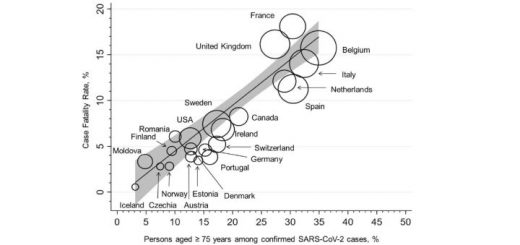Case fatality rate in Hong Kong
Is the low case ratality rate of COVID-19 in Hong Kong deceptive? During the first weeks of the SARS-CoV-2 pandemic, a very low CFR of only 0.4% has been reported (Lui GC 2000). Is this mainly due to the low number of older persons among the confirmed SARS-CoV-2 cases? Hoffmann and Wolf show that the overall CFR in Hong Kong has increased since then, paralleling the increasing proportion of older persons among confirmed cases.
* * *
Last Monday, we published data from the 20 most affected European countries and the USA and Canada, showing that during the first wave of the pandemic, the variance of crude CFR of COVID-19 was predominantly (80-96%) determined by the proportion of older individuals who are diagnosed with SARS-CoV-2 (Hoffmann 2020). [Older age groups and country-specific case fatality rates of COVID-19 in Europe, USA and Canada. Infection. 2020 Oct 24:1-6. PubMed: https://pubmed.gov/33098532. Full-text: https://doi.org/10.1007/s15010-020-01538-w]

Figure 1. Association between case fatality rate (CFR) and the proportion of persons over 75 years of age among all confirmed SARS-CoV-2 cases (R2 = 0.8034, p < 0.0001). The circle sizes reflect the countryspecific numbers of COVID- 19-associated deaths per million habitants; the linear fit prediction plot with a 95% confidence interval was estimated by weighted linear regression (weight = total number of COVID-19-associated deaths). Reproduced with permission.

Figure 2. Age- and gender-specific CFR (percentage) for the eight countries in which these data were available. The relative risk (or risk ratio; i.e., RR) for men compared to women was highest in younger age groups. In individuals aged < 60 years, 60–79 years and > 80 years, the estimated overall RR for men versus women was 2.65 (95% CI 2.18–3.21), 1.73 (1.55–1.93) and 1.50 (1.36–1.65), respectively. Reproduced with permission.
Here we show that our model might apply to other countries. In Hong Kong, for example, a very low CFR of only 0.4% has been reported during the first weeks (Lui GC 2000). In contrast to the authors, we believe that this was mainly due to the low number of older persons among the confirmed SARS-CoV-2 cases. We also show that the overall CFR in Hong Kong has increased since then, paralleling the increasing proportion of older persons among confirmed cases. Thanks to the incredible speed of Clinical Infectious Diseases’ publishing policies (contrasting many other journals), the authors from Hong Kong have been already able to respond (in some points they agree, in other points they don’t). Please read the discussion (Lui GC 2000).

Figure 1. Case Fatality Rate (CFR) and the proportion of persons over 70 years of age among all confirmed SARS-CoV-2 cases for the 20 most affected European countries, USA, Canada and for Hong Kong. Age distribution of confirmed cases and deaths were extracted from national health authority websites by July 6, 2020 (for details see [2]). The light grey bubble indicates values in Hong Kong from January 23 to April 15 (HK Phase I, n = 1,023), the darker bubble indicates values in the time period from April 16 to October 6, 2020 (HK Phase II, n = 4,120). Note: The black dot within the light grey bubble indicates Iceland which, among European countries, had the lowest CFR and lowest proportion of older people among confirmed cases, with rates very similar to Hong Kong during Phase I.
Why is this important? In many countries facing a low CFR during the first wave, there is a widespread feeling that this was mainly due to a good health care system such as ICU or testing capacities. We believe that this perception can be deceptive and that the picture in these countries will change immediately when more elderly people are infected.
Hoffmann C, Wolf E. The Low Case Fatality Rate of COVID-19 in Hong Kong Could Be Deceptive. Clin Infect Dis. 2020 Oct 29:ciaa1676. PubMed: https://pubmed.gov/33119056 . Full-text: https://doi.org/10.1093/cid/ciaa1676
Lui GC, Yip TC, Wong VW, et al. Significantly Lower Case-fatality Ratio of Coronavirus Disease 2019 (COVID-19) than Severe Acute Respiratory Syndrome (SARS) in Hong Kong-A Territory-Wide Cohort Study. Clin Infect Dis. 2020 Oct 1:ciaa1187. PubMed: https://pubmed.gov/33005933. Full-text: https://doi.org/10.1093/cid/ciaa1187
Lui CG, Yip TC, Hui D, et al. Reply to Hoffmann and Wolf. Clinical Infectious Diseases, October 29, ciaa1678, https://doi.org/10.1093/cid/ciaa1678. Download PDF.



